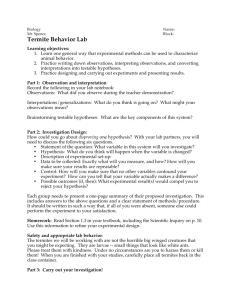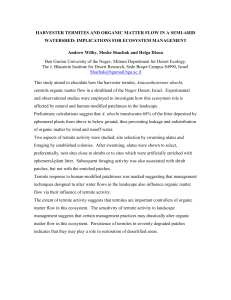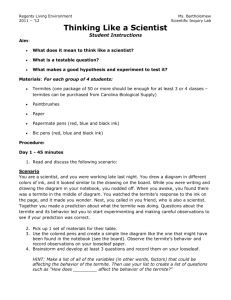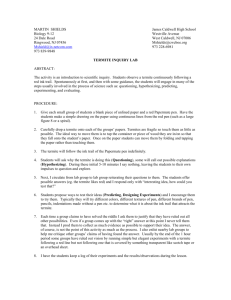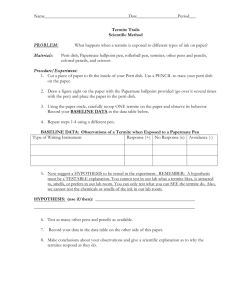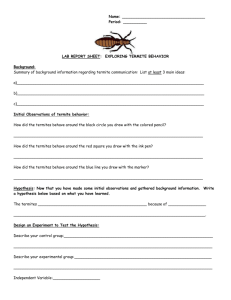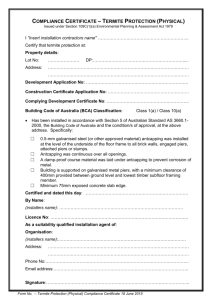Behavioral Ecology of Subterranean Termites and Implications for Control J. Kenneth Grace 1
advertisement
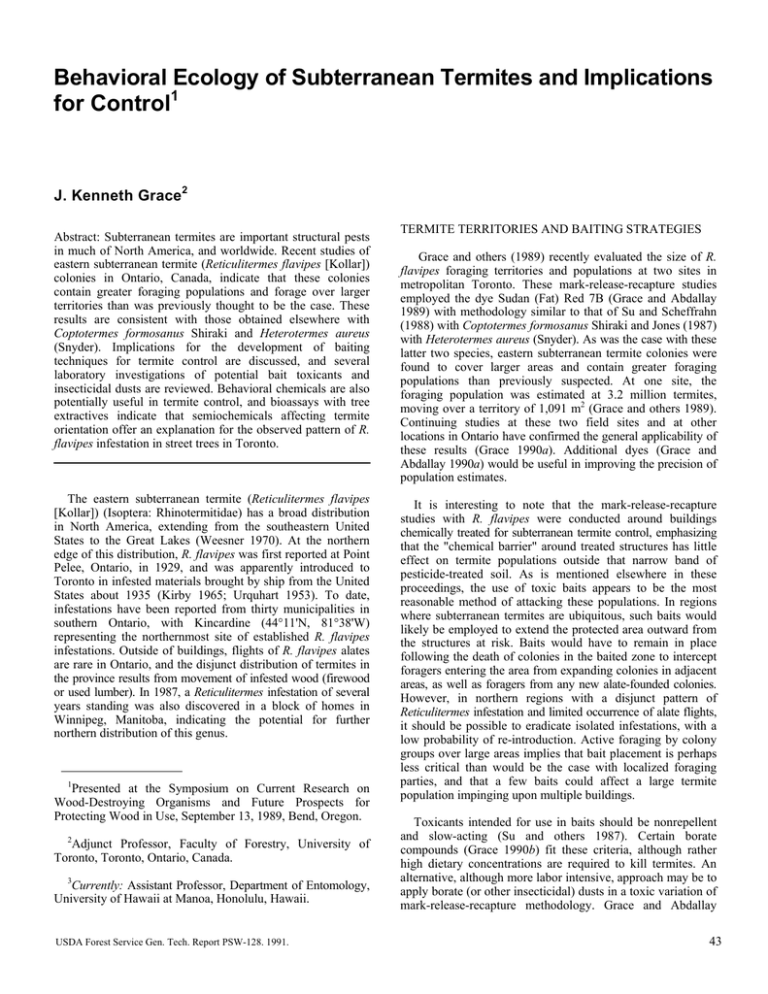
Behavioral Ecology of Subterranean Termites and Implications for Control1 J. Kenneth Grace2 Abstract: Subterranean termites are important structural pests in much of North America, and worldwide. Recent studies of eastern subterranean termite (Reticulitermes flavipes [Kollar]) colonies in Ontario, Canada, indicate that these colonies contain greater foraging populations and forage over larger territories than was previously thought to be the case. These results are consistent with those obtained elsewhere with Coptotermes formosanus Shiraki and Heterotermes aureus (Snyder). Implications for the development of baiting techniques for termite control are discussed, and several laboratory investigations of potential bait toxicants and insecticidal dusts are reviewed. Behavioral chemicals are also potentially useful in termite control, and bioassays with tree extractives indicate that semiochemicals affecting termite orientation offer an explanation for the observed pattern of R. flavipes infestation in street trees in Toronto. The eastern subterranean termite (Reticulitermes flavipes [Kollar]) (Isoptera: Rhinotermitidae) has a broad distribution in North America, extending from the southeastern United States to the Great Lakes (Weesner 1970). At the northern edge of this distribution, R. flavipes was first reported at Point Pelee, Ontario, in 1929, and was apparently introduced to Toronto in infested materials brought by ship from the United States about 1935 (Kirby 1965; Urquhart 1953). To date, infestations have been reported from thirty municipalities in southern Ontario, with Kincardine (44°11'N, 81°38'W) representing the northernmost site of established R. flavipes infestations. Outside of buildings, flights of R. flavipes alates are rare in Ontario, and the disjunct distribution of termites in the province results from movement of infested wood (firewood or used lumber). In 1987, a Reticulitermes infestation of several years standing was also discovered in a block of homes in Winnipeg, Manitoba, indicating the potential for further northern distribution of this genus. 1 Presented at the Symposium on Current Research on Wood-Destroying Organisms and Future Prospects for Protecting Wood in Use, September 13, 1989, Bend, Oregon. 2 Adjunct Professor, Faculty of Forestry, University of Toronto, Toronto, Ontario, Canada. 3 Currently: Assistant Professor, Department of Entomology, University of Hawaii at Manoa, Honolulu, Hawaii. USDA Forest Service Gen. Tech. Report PSW-128. 1991. TERMITE TERRITORIES AND BAITING STRATEGIES Grace and others (1989) recently evaluated the size of R. flavipes foraging territories and populations at two sites in metropolitan Toronto. These mark-release-recapture studies employed the dye Sudan (Fat) Red 7B (Grace and Abdallay 1989) with methodology similar to that of Su and Scheffrahn (1988) with Coptotermes formosanus Shiraki and Jones (1987) with Heterotermes aureus (Snyder). As was the case with these latter two species, eastern subterranean termite colonies were found to cover larger areas and contain greater foraging populations than previously suspected. At one site, the foraging population was estimated at 3.2 million termites, moving over a territory of 1,091 m2 (Grace and others 1989). Continuing studies at these two field sites and at other locations in Ontario have confirmed the general applicability of these results (Grace 1990a). Additional dyes (Grace and Abdallay 1990a) would be useful in improving the precision of population estimates. It is interesting to note that the mark-release-recapture studies with R. flavipes were conducted around buildings chemically treated for subterranean termite control, emphasizing that the "chemical barrier" around treated structures has little effect on termite populations outside that narrow band of pesticide-treated soil. As is mentioned elsewhere in these proceedings, the use of toxic baits appears to be the most reasonable method of attacking these populations. In regions where subterranean termites are ubiquitous, such baits would likely be employed to extend the protected area outward from the structures at risk. Baits would have to remain in place following the death of colonies in the baited zone to intercept foragers entering the area from expanding colonies in adjacent areas, as well as foragers from any new alate-founded colonies. However, in northern regions with a disjunct pattern of Reticulitermes infestation and limited occurrence of alate flights, it should be possible to eradicate isolated infestations, with a low probability of re-introduction. Active foraging by colony groups over large areas implies that bait placement is perhaps less critical than would be the case with localized foraging parties, and that a few baits could affect a large termite population impinging upon multiple buildings. Toxicants intended for use in baits should be nonrepellent and slow-acting (Su and others 1987). Certain borate compounds (Grace 1990b) fit these criteria, although rather high dietary concentrations are required to kill termites. An alternative, although more labor intensive, approach may be to apply borate (or other insecticidal) dusts in a toxic variation of mark-release-recapture methodology. Grace and Abdallay 43 (1990b) demonstrated in laboratory assays that coating 5-10 percent of the individuals in groups of 20-40 R. flavipes workers with boric acid or barium metaborate dusts resulted in 28-100 percent mortality within 16 days. Subterranean termite foragers collected in traps such as those described by Grace (1989) and Su and Scheffrahn (1986) could be coated with such toxic dusts and released back into the traps to poison other colony members through mutual grooming behaviors. Collections from multiple traps at each site and multiple capture and release cycles could be employed to treat a sufficiently large proportion of the population to kill the entire colony. and others 1988) and diffused through the soil (Clement and others 1988). An alternative to the use of chemical insecticides in termite baiting systems is the use of microbial biological control agents, such as nematodes or fungi. In Ontario, and other areas of subterranean termite introductions, surveys of the mycoflora associated with termites may reveal potential pathogens. Zoberi and Grace (1990a) isolated 40 fungal species from R flavipes and associated materials. Several of these fungi have been previously reported to be facultative insect pathogens, and a number (e.g., Arthrobothrys oligospora Fresenius, Cunninghamella echinulata Thaxter, and Rhizopus stolonifer Ehrenb. ex Fr.) appear to be detrimental to termite survival in preliminary bioassays. The well-known pathogenic fungus Beauveria bassiana [Balsamo] Vuillemin was also recently isolated from R. flavipes workers infesting a street tree in Toronto (Zoberi and Grace 1990b). In 1980, an inspection of 17,800 street and park trees in metropolitan Toronto revealed termite shelter tubing on 4 percent of those trees (Cooper and Grace 1987). Subsequently, two tree species commonly occurring in Toronto were selected to determine whether chemical factors were involved in the pattern of differential infestation of street trees observed in the 1980 survey. Subterranean termite tubing was found on 19.3 percent of the horsechestnuts (Aesculus hippocastanum L.) (Hippocastanaceae) inspected, ranking it as a frequently infested tree species. On tree of heaven (Ailanthus altissima [Mill.] Swingle) (Simaroubaceae), however, shelter tubing was noted on only 0.7 percent of the trees inspected, suggesting that it is rarely infested (Cooper 1981). Although attractant or arrestant semiochemicals would be useful in masking otherwise repellent bait toxicants, the high level of foraging activity of R. flavipes at field sites in Ontario indicates that neither decayed wood nor attractant chemicals are necessary prerequisites to implementation of baiting techniques, so long as the feeding substrate or bait toxicant within the collection unit is not repellent. Use of a collection trap is certainly more labor intensive than placement of the toxicantimpregnated decayed-wood blocks originally used to control termites in this manner (Ostaff and Gray 1975). However, it also offers more control possibilities (such as incorporating dusts) and a means of quantifying the decline in the termite population by post-treatment monitoring and mark-releaserecapture methods. Post-treatment bait units, supplemented by wooden stakes, could remain in place both to confirm the efficacy of the control method and as an aid in subsequent inspections of the property for new termite infestations. SEMIOCHEMICALS IN ORIENTATION AND FEEDING Eastern subterranean termite responses to behavioral chemicals (semiochemicals) may help to explain observed patterns of termite foraging, and may also be useful adjuncts to baiting systems. Low concentrations of the microbicide TCMTB, for example, are repellent to R. flavipes, and might protect wood from termite attack more effectively than toxic but nonrepellent preservatives (Grace 1988). Attractants and arrestant semiochemicals, on the other hand, might be used to enhance feeding on baits and to direct foragers towards baits or toxicant-treated soil. Reticulitermes workers are able to orient to chemical gradients, both on two-dimensional trails (Grace 44 In Toronto and other northern locales, R. flavipes infests living trees as well as cellulosic debris and wood in service. Shelter tubes are constructed in bark fissures upward from the base of the tree stem, and termites are active between the inner and outer bark. Although feeding is limited to dead portions of the tree, such as the heartwood and fungus-decayed limbs, some scarring of the bark and sapwood surfaces is also apparent. The bark, sapwood, and heartwood of these two tree species were each extracted in a series of solvents (chloroform:acetone, methanol, acetone, hexane), and the resulting extracts applied to filter paper and exposed to R. flavipes workers in no-choice laboratory assays (Grace, in preparation).4 All extracts were assayed at 4 percent (weight/weight) concentrations, although the yields from extraction ranged from 0.3-10.2 percent (wt./wt.). Only the hexane extract of A. altissima heartwood caused significant termite mortality within 15 days. However, the yield of hexane extractives from A. altissima heartwood was only 0.3 percent (wt./wt.). Since it was assayed at a 4 percent concentration, this suggests that less mortality might be expected from termite feeding on the natural substrate. The orientation responses of individual R. flavipes workers to these extracts were evaluated in behavioral assays (Grace, in preparation).4 In these assays, a single worker was placed between a 23 mm diameter paper disk treated with 4 percent (wt./wt) extractives and a second solvent-treated control disk in a small glass petri dish. The position of the worker (in contact with either or neither paper disk) was recorded every 30 seconds over a 20-minute interval. This assay was repeated with 50 workers exposed to each of the 12 extracts from the two tree species, and the proportions in contact with the extract-treated and the control disks compared (pairedcomparisons t test). Seven of the 12 horsechestnut extracts elicited significant (p ≤ 0.05) positive orientation responses, and 3 elicited significant negative responses. The opposite trend 4 Data on file, Department of Entomology, University of Hawaii, Honolulu, Hawaii. USDA Forest Service Gen. Tech. Report PSW-128. 1991. was observed with tree of heaven, for which 7 of the solvent extracts elicited negative responses, and only two elicited positive responses. In addition, the A. hippocastanum extractives eliciting the strongest positive orientation responses and the A. altissima extractives eliciting the strongest negative responses were present in high concentration in their respective wood matrices. Thus, semiochemical-mediated orientation behavior and initiation of feeding on a particular tree species may explain differential infestation of otherwise equally suitable substrates. ACKNOWLEDGMENTS These studies were supported by grants from the Ontario Ministry of the Environment, Ontario Ministry of Housing, Canada Mortgage and Housing Corporation, Ontario Real Estate Association Foundation, Toronto Real Estate Board, US Borax Corporation, and the municipalities of East York, Etobicoke, Guelph, Hamilton, Kincardine, Leamington, North York, Oakville, Scarborough, and Toronto. REFERENCES Clement, J.L.; Lemaire, M.; Nagnan, P.; Escoubas, P.; Bagneres, A.G.; Joulie, C. 1988. Chemical ecology of European termites of the genus Reticulitermes. Allomones, pheromones and kairomones. Sociobiology 14: 165-174. Cooper, P.A. 1981. The subterranean termite (Reticulitermes flavipes) - its activity and control in shade trees. Toronto: Faculty of Forestry, Univ. of Toronto. 25 p. Final Report to the Ontario Shade Tree Council. Cooper, P.A.; Grace, J.K. 1987. Association of the eastern subterranean termite, Reticulitermes flavipes (Kollar), with living trees in Canada. Journal of Entomological Science 22: 353-354. Grace, J.K 1988. Toxicity and repellency of the fungicide TCMTB to the eastern subterranean termite (Isoptera: Rhinotermitidae). Proceedings of the Entomological Society of Ontario 119: 83-85. Grace, J.K. 1989. A modified trap technique for monitoring Reticulitermes subterranean termite populations (Isoptera: Rhinotermitidae). Pan-Pacific Entomologist 65: 381-384. Grace, J.K. 1990a. Mark-recapture studies with Reticulitermes flavipes (Isoptera: Rhinotermitidae). Sociobiology. [In press]. Grace, J.K 1990b. Oral toxicity of barium metaborate to the eastern subterranean termite (Isoptera: Rhinotermitidae). Journal of Entomological Science. [In press]. USDA Forest Service Gen. Tech. Report PSW-128. 1991. Grace, J.K.; Abdallay, A. 1989. Evaluation of the dye marker Sudan Red 7B with Reticulitermes flavipes (Isoptera: Rhinotermitidae). Sociobiology 15: 71-77. Grace, J.K.; Abdallay, A. 1990a. A short-term dye for marking eastern subterranean termites (Reticulitermes flavipes Koll., Isoptera, Rhinotermitidae). Journal of Applied Entomology. [In press]. Grace, J.K.; Abdallay, A. 1990b. Termiticidal activity of boron dusts (Isoptera, Rhinotermitidae). Journal of Applied Entomology. [In press]. Grace, J.K; Abdallay, A.; Farr, KR. 1989. Eastern subterranean termite (Isoptera: Rhinotermitidae) foraging territories and populations in Toronto. Canadian Entomologist 121: 551556. Grace, J.K.; Wood, D.L.; Frankie, G.W. 1988. Trail-following behavior of Reticulitermes hesperus Banks (Isoptera: Rhinotermitidae). Journal of Chemical Ecology 14: 653667. Jones, S.C. 1987. Foraging Party and Territory Size of the Desert Subterranean Termite Heterotermes aureus (Snyder) in a Sonoran Desert Grassland. Tucson: Univ. of Arizona; Ph.D. Dissertation. Kirby, C.S. 1965. The distribution of termites in Ontario after 25 years. Canadian Entomologist 97: 310-314. Ostaff, D.; Gray, D.E. 1975. Termite (Isoptera) suppression with toxic baits. Canadian Entomologist 107: 1321-1325. Su, N.-Y.; Scheffrahn, R.H. 1986. A method to access, trap, and monitor field populations of the Formosan subterranean termite (Isoptera: Rhinotermitidae) in the urban environment. Sociobiology 12: 299-304. Su, N.-Y.; Scheffrahn, R.H. 1988. Foraging population and territory of the Formosan subterranean termite (Isoptera: Rhinotermitidae) in an urban environment. Sociobiology 14: 353-359. Su, N.-Y.; Tamashiro, M.; Haverty, M.I. 1987. Characterization of slow-acting insecticides for the remedial control of the formosan subterranean termite (Isoptera: Rhinotermitidae). Journal of Economic Entomology 80: 1-4. Urquhart, F.A. 1953. The introduction of the termite into Ontario. Canadian Entomologist 85: 292-293. Weesner, F.M. 1970. Termites of the nearctic region. In: Krishna, K; Weesner, F.M., eds. Biology of termites, volume II. New York: Academic Press; 477-525. Zoberi, M.H.; Grace, J.K. 1990a. Fungi associated with the subterranean termite Reticulitermes flavipes (Kollar) in Ontario. Mycologia [In press]. Zoberi, M.H.; Grace, J.K. 1990b. Isolation of the pathogen Beauveria bassiana from Reticulitermes flavipes (Isoptera: Rhinotermitidae). Sociobiology. [In press]. 45
